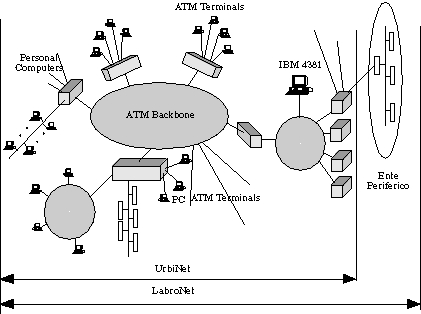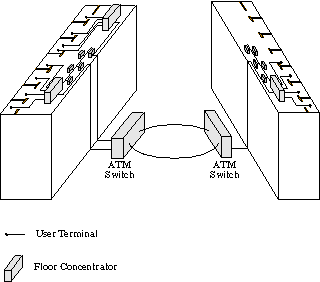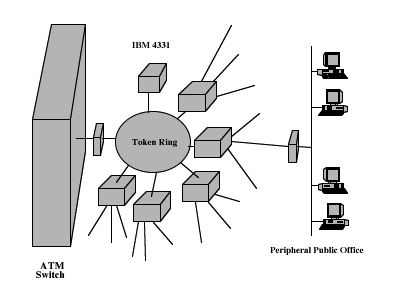
Figure 1: UrbiNet and LabroNet

by Luciano Lenzini
The LabroNet architecture has been designed for the Livorno Town Council. It permits rapid and efficient communication between the council offices and with other users in the town and throughout the country. The local networks (LAN's) already in operation in the offices can be integrated (in a user transparent fashion) without having to invest in new equipment, and new users can be linked to the network according to the rules imposed by the structured cabling system which will be deployed in each of the council buildings. The network technology adopted by LabroNet integrates traffic of different characterstics, i.e., data, voice, video, and this will allow end users to employ new services such as multimedia.
Livorno (Leghorn) is a provincial capital in the Region of Tuscany. Its port looks out onto the Tyrrhenian Sea and is one of the most important in the Mediterranean. The offices of Town Council are spread over three buildings. Although council workers use heterogeneous equipment both in terms of make (IBM, NCR) and power (PC, WS, Mainframe), they nevertheless need to communicate with each other and with other users both in Livorno and throughout the rest of Italy. The Livorno Council has thus designed a three-level hierarchical architecture (see Figure 1) which will most likely be implemented in the second half of this year. This architecture will allow the integration of services (data, voice and video) so that multimedia applications can be supported. New users can decide to link to the network in ATM mode or through the most appropriate local network protocol (Ethernet, Token Ring, etc.). The physical linking of all users to the network is standardized. The resulting network structure is not only highly flexible with reference to end-user connection, but is extendable, i.e. there are no limits to the geographical distribution of the network and the number of users. Furthermore, LabroNet, uses an avant-garde technology (ATM) which can supply the user with a range of services, such as multmedia, which are not available using traditional LAN's.

Figure 1: UrbiNet and LabroNet
The LabroNet architecture is structured in three levels as follows:
Level 1
A backbone with very high transmission speeds (no lower than 100 Mbps) implemented by two ATM switches connected by a multimodal optic fiber link.
Level 2
A set of "horizontal" concentrators, named floor concentrators, varying from one to three, for each floor in each building. These concentrators are star-linked to the ATM switches via a multimodal optic fiber link. They have a passive and an active part. The passive part concentrates "copper" lines coming from the different offices. The active part interfaces bridges, Ethernet and Token Ring ports to the ATM protocols.
Level 3
Local networks installed at peripheral public offices and linked to the computer center of the Council. These links will be made using the "common" transmission technology made available by Telecom Italia, and in addition Level 3 will enter into the network through Level 2.
Following this architecture, communication within the Council (levels 1 and 2) will be made via a high speed telecommunication structure named UrbiNet (Urbi Network), whereas external communication (Level 3) will use the Telecom Italia transmission technologies. The resulting global network will be known as LabroNet (Labronica Network). Via gateways, this network will be interconnected to the international Internet system and also to the Italian public packet-switching network (ITAPAC).
The Cabling System of the Buildings
UrbiNet will use a structured cabling system (Figure 2) which will allow changes in destinations, extensions and related modifications in any working area, even during the planning stage. Furthermore, it sets a uniform manner for connecting user equipment to the floor concentrators. There is one cabling system in each council office. These cabling systems are interlinked via two ATM switches (one managing two offices) so that there is an end-to-end connectivity between the UrbiNet terminals.

Figure 2: The UrbiNet Structured Cabling System
Connecting LabroNet Peripheral Public Offices
There are currently 30 public offices in the city that already interact with the computer systems of the three council buildings in Livorno, via point-to-point links or multipoint links. Within the LabroNet framework, the following interconnection architecture is proposed: a LAN, within each public office, via a router and point-to-point telecommunication link, reaches a router connected to the Token Ring which forms part of UrbiNet. To overcome problems of reliability, four routers will be employed on the Token Ring side, as shown in Figure 3, instead of using just one router that concentrates on all the peripheral lines.

Figure 3: Connecting the Peripheral Public Offices